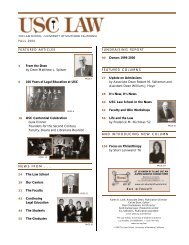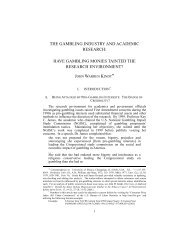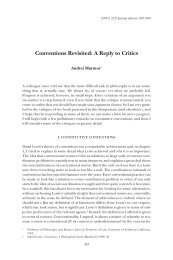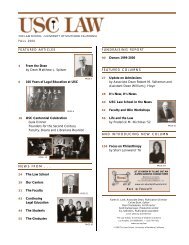1 Regulating Sex Work Adrienne D. Davis VERY ROUGH DRAFT ...
1 Regulating Sex Work Adrienne D. Davis VERY ROUGH DRAFT ...
1 Regulating Sex Work Adrienne D. Davis VERY ROUGH DRAFT ...
Create successful ePaper yourself
Turn your PDF publications into a flip-book with our unique Google optimized e-Paper software.
took sex seriously as work, while simultaneously confronting the real and high<br />
vulnerability its workers experience?<br />
A. Markets for <strong>Sex</strong><br />
Section II argued that assimilationists’ insistence that sex work be regulated like “any<br />
other labor” ignores the diversity of workplaces. This section makes an additional point.<br />
In the strong form version the homogeneity of labor claim insists and in the weak form<br />
assumes that sexual labor is no different from other, non-sexual work. But, as this next<br />
part shows, sex workplaces are not like most workplaces. Rather, they are distinct in<br />
ways that have regulatory significance.<br />
<strong>Sex</strong> workers, typically women or trans, cater to a customer base that is<br />
overwhelmingly male. 204205 <strong>Sex</strong> work is not alone in these ratios, but it can engender<br />
distinct dynamics that pose real risk to the workers. For instance dancers frequently work<br />
for multiple customers simultaneously, either in clubs or for parties—bachelor, fraternity,<br />
work, etc.—at outcall locations. 206 These customers often patronize them in all-male<br />
groups, seeking and expecting homosocial bonding through drinking and verbal and/or<br />
physical sexual interaction with the dancer(s). As several sociological studies have<br />
found, participants in these spaces may experiment with and negotiate social norms and<br />
expectations of masculinity that differ from and would be sanctioned and deemed<br />
unacceptable in other social contexts. 207 [see if you can find anything on not unlike<br />
“mobs” that turn on one outsider and lots of insiders?] Customers’ significant alcohol<br />
consumption can further loosen social inhibitions and lubricate behavior that puts<br />
workers at risk of both verbal abuse and violence. 208 Heightening the risk to workers, in<br />
clubs not only are the customers often intoxicated but dancers’ “labor” may entail<br />
“hustling” drinks from customers, which the dancers are then expected to drink. 209<br />
Unlike other workers, some sex professionals are expected to labor in a state in which<br />
their own judgment is definitionally impaired. 210211212 This particular combination of<br />
204 “an overwhelmingly female work force that services an overwhelmingly male clientele. (Male<br />
prostitutes also work for predominantly male customers.)” Chancer 151; [craft footnote on gender ratios<br />
and dynamics; where can we find this?]<br />
205 Trans.<br />
206 [some men, often regulars, patronize on their own; start by looking at Siobhan Brooks’ book]<br />
207 [find quote that the behavior is risky to the dancers.]<br />
208 The service is also contingent on the customer’s own performance and body. Many men anticipate and<br />
expect erections and orgasm from their paid sexual encounters. Not all sex work requires this; specialized<br />
and fetish markets, for instance may not. Other work also relies on bodily exertions, innate talents, or<br />
developed skills from customers. Personal trainers, sports coaches, and x each rely on some type of<br />
physical exertion and talent or skills from their client. Still, sexual expectations can create a different and<br />
the stress it can induce on the customer. This can be a prompt for violence, as it undoubtedly is not among<br />
trainees or athletes taking lessons who feel they are not performing to the social or trainer’s expectations.<br />
209 [add citation]<br />
210 In contrast, most workers do not work in an intoxicated state, and indeed, doing so would be grounds for<br />
termination./As an initial matter, in most workplaces, workers are not permitted to drink alcohol. In fact,<br />
drinking on the job would be grounds for termination from many jobs (although there are some curious<br />
exemptions: many professionals may drink or are expected to drink when entertaining clients). This rule<br />
extends to those who work in market sectors that serve alcohol, including restaurant, casino, and bars<br />
[check this]./ Even workers who serve alcohol, i.e., food servers, bartenders, liquor salespeople, and casino<br />
workers, typically have restrictions or limits imposed on how much and when they can drink themselves.<br />
36














